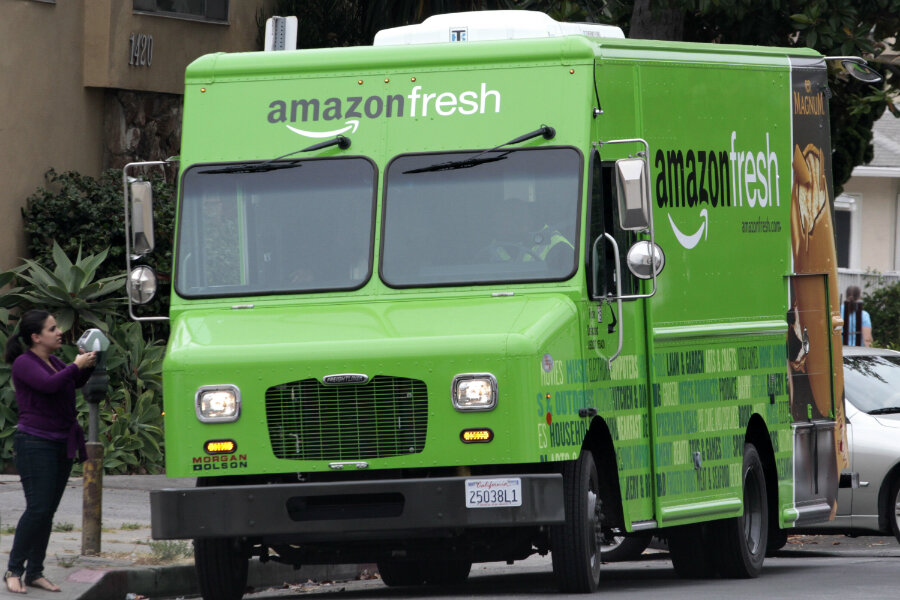Amazon is planning to open brick-and-mortar grocery stores
Loading...
Amazon is often seen as the disruptor, the company that drove retail sales online and sent brick-and-mortar stores scrambling to innovate. But now there are reports that the e-commerce giant is venturing into the traditional market of grocery shopping – and doing it the old way, by opening physical stores.
According to The Wall Street Journal, Amazon plans to open convenience stores that sell perishable goods such as milk and produce and drive-in pickups for customers who placed their orders online. The company is even developing license-plate reading technology to speed up grocery pickups.
Amazon's project will bring it head to head in competition with Wal-Mart, which is also in the midst of driving up its online sales and offering drive-by pickups for online orders. Competition for grocery sales can be crucial since restocking home refrigerators creates a perpetual market for groceries, and more consumers may be choosing to do so online.
Despite the similarities in its online strategies, the two competitors have one crucial difference: Wal-Mart, which already has a strong physical presence, is embracing digital shopping to catch up with the times, while Amazon, with its online dominance, is recognizing the values of physical stores.
Their strategies may be specific to the food and beverage industry: customers have traditionally been wary of letting others pick their meat and milk, but, at the same time, seek convenience in grocery shopping – such as a speedy pickup on the way home from work.
The ideal situation may be having both online and in-store options, although as people become more comfortable with online purchases, the tide may turn in favor of Amazon’s online strategy.
"The U.S. food and beverage grocery market has reached a tipping point, in our view," Cowen and Co. analyst John Blackledge said in an industry report this year, according to CNBC. Mr. Blackledge estimated that as consumers become more comfortable with purchasing groceries online, Amazon may become the seventh-largest food and beverage retailer by 2021.
Amazon's project, known internally as Project Como, is not its first venture in the food and beverage market. Amazon Fresh, a service that delivers fresh groceries for an annual fee, was launched and expanded to several cities in 2013.
Wal-Mart currently holds the biggest market share in grocery sales. According to CNBC, it has rolled out its online grocery business and drive-in services to 80 markets and 500 stores. By the end of this year, it expects to be in 100 markets and 600 stores.
"We're going to be really focused on winning in fresh and consumables over the next couple years," Marc Lore, the head of Wal-Mart's e-commerce, told The Wall Street Journal.
In August, Wal-Mart bought Jet.com, an e-commerce discount store that specializes in offering deals. Online growth for Wal-Mart had been slow, and it hoped that with the acquisition of Jet, it would obtain valuable technology, pricing software and warehouses.
Other traditional grocery stores and startups are also vying for market share, including Kroger, with its ClickList program that offers curbside pickups and home deliveries.
"Consumers appear to favor services and experiences over merchandise," the National Retail Foundation wrote in June, citing Bryan Gildenberg, the chief knowledge officer of Kantar Retail, as saying the group's research indicates that by 2020, customers will spend $2 on services for every $1 on "stuff."
Will Amazon’s stores win out its competitors? It might be tough, as grocery giants like Wal-Mart, Kroger, and Giant already have existing infrastructure to deal with the challenges of storing fresh goods, establishing delivery systems, and space for pickups. As Sarah Halzack with The Washington Post writes, "Grocery is something of the final frontier of the online shopping revolution.... [A]nd retailers have had a hard time figuring out a durable business model, since the grocery world already operates on razor-thin profit margins."
But Amazon already has a notorious ability to break into new markets and embrace change. It did so by boosting online book sales – and then opening a brick-and-mortar bookstore in Seattle last year.
"Amazon is now moving into the very space it forced some sellers to abandon, having in no small part contributed to the decline of companies like Barnes and Noble," as The Christian Science Monitor staff writer Jason Thompson wrote in May.








